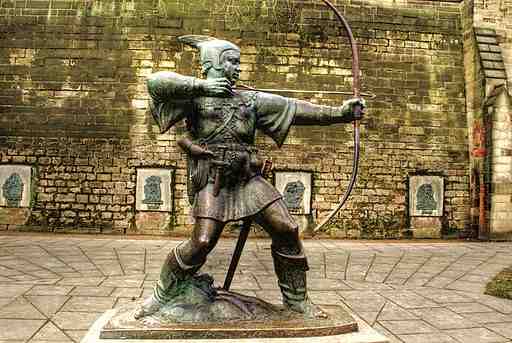
October 28, 2013, by Nicola Royan
What is Robin Hood?
I’d never really thought of Robin Hood as jousting. A mean sword fighter, yes; good with the quarter staff, if not as good as Little John; and of course superlative with a long bow. Just not the lance. So it took me a few moments to re-orientate myself at the Robin Hood Pageant at Nottingham Castle today, when Robin Hood jousted with the Sheriff of Nottingham for Marian’s freedom. My children, on the other hand, were not in the least concerned; indeed, my son (5) was delighted to be absolutely clear on the identity of the ‘goodies’, and despite having tried his hand at archery earlier in the day, did not feel the lack of the bow. Of course, the children are right to be unperturbed by the modification of the heroic figure to fit current circumstances. They were clear that he had the moral high ground and the loyal supporters, and equally clear that his opponents, led by the Sheriff, were ‘baddies’. Obviously, a man who cheats in tournament by using an unblunted lance and challenges the referee’s, sorry the Marshall’s, decision, and whose followers refer to the crowd as ‘pig ugly peasants’ is not a good man. The use of ‘peasants’ as an insult (taken very badly by my daughter (8)) was the only direct reference to Robin’s other , more political, association with the poor against the rich. At the rest of the event, there was a good deal of effort to present a historical context for Robin Hood. There were re-enactors demonstrating sword techniques, 12th C food, living quarters and bedding, there were craft stalls with coin minting, candle making, wood whittling, and whatever the apothecary was doing (we couldn’t fight our way through the crowd). The combat that happened was a medieval in style, although probably with significantly less actual personal injury. The marshalls even did their best to convey historical detail of melée and joust, armour and weaponry, although if my two were typical, I suspect the finer points were lost on some of the audience. On the part of the performers, there was evident a dedication to presenting the past as well and as interestingly as it can be done. But what does such an event suggest about attitudes to Robin Hood? There were certainly civic pride in his association with Nottingham; he was a way into medieval history and culture for many people there, whether they were conscious of it or not; and he was an unequivocal hero to cheer in the jousting (and those are probably scarcer than we like to think!) In short, he was a nexus for a whole series of complex associations and understandings about the past and our inherited identities. That sounds very grand, I know, but portrayals of Robin Hood can reveal various tensions and concerns of wider culture. At an event on Wednesday 30 October at the University of Nottingham, three academic specialists, Dr Lesley Coote (Hull), Professor Tony Pollard (Teesside) and Dr Juliette Wood (Cardiff), will discuss this very topic, Robin’s appearances through the centuries, to consider their significance for wider culture. For more details, see http://www.nottingham.ac.uk/medieval/events/robin-hood.aspx
No comments yet, fill out a comment to be the first

Leave a Reply